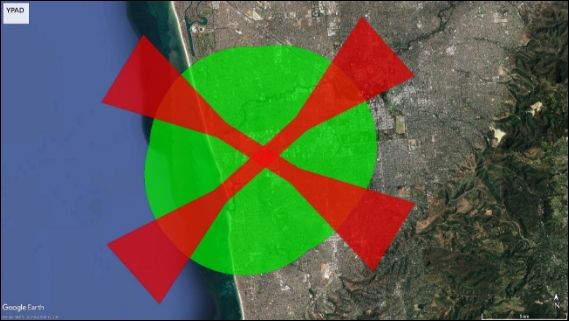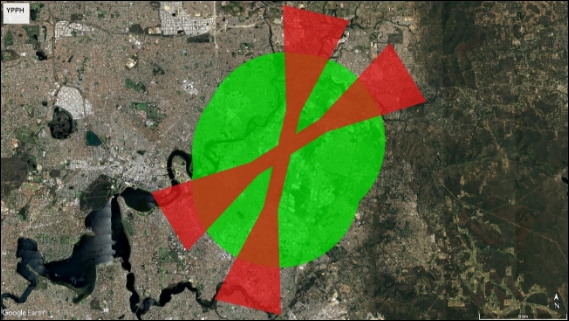Instrument number CASA 29/22
I, ALISON DIANNE HAYWARD, Acting Branch Manager, Remotely Piloted Aircraft Systems, a delegate of CASA, make this instrument under regulations 11.056 and 101.030 of the Civil Aviation Safety Regulations 1998.
[Signed A. Hayward]
Alison Hayward
Acting Branch Manager, Remotely Piloted Aircraft Systems
13 May 2022
CASA 29/22 – Area Approval for Operation of RPA within 3 NM of Controlled Aerodromes using CASA-verified Drone Safety App – Canberra (YSCB), Adelaide (YPAD) and Perth (YPPH) Instrument 2022
1 Name
This instrument is CASA 29/22 – Area Approval for Operation of RPA within 3 NM of Controlled Aerodromes using CASA-verified Drone Safety App – Canberra (YSCB), Adelaide (YPAD) and Perth (YPPH) Instrument 2022.
2 Duration
The instrument:
(a) commences on 15 May 2022; and
(b) is repealed at the end of 15 November 2022.
3 Repeal
Instrument CASA 97/21 – Area Approval and Direction for Operation of RPA within 3 NM of Controlled Aerodromes using CASA-verified Drone Safety App – Canberra (YSCB), Adelaide (YPAD) and Perth (YPPH) Instrument 2021 is repealed.
4 Definitions
Note In this instrument, certain terms and expressions have the same meaning as they have in the Civil Aviation Act 1988 and the regulations. These include: aerodrome, AGL, air traffic control (ATC), controlled aerodrome, RPA and RPAS.
In this instrument:
airspace authorisation means the text and graphical depiction provided to a person by a CASA-verified drone safety app authorising the person to operate an RPA in the operating area.
approved area has the meaning given by regulation 101.236 of CASR.
CASA-verified drone safety app means a software application that is connected to the CASA RPAS digital platform, verified by CASA to provide airspace authorisations and listed as a verified app on the CASA website.
Note The CASA website address is https://www.casa.gov.au/drones/safety-apps.
operating area means the segment of airspace described in the airspace authorisation, defined with reference to horizontal and vertical limits within an approved area, in which an RPA may operate.
RPA operator means the holder of a certificate as an RPA operator under Division 101.F.4 of CASR.
5 Approval
(1) For regulation 101.030 of CASR, each of the following areas below 400 feet AGL is approved for the operation of RPA:
(a) the area within 3 NM of Canberra aerodrome (YSCB), the coordinates for which are specified in the file YPPH_YPAD_YSCB_v3_0.json dated 15 May 2022 (Version 3) on a CASA-verified drone safety app and represented in Schedule 1 as the green area;
(b) the area within 3 NM of Adelaide aerodrome (YPAD), the coordinates for which are specified in the file YPPH_YPAD_YSCB_v3_0.json dated 15 May 2022 (Version 3) on a CASA-verified drone safety app and represented in Schedule 2 as the green area;
(c) the area within 3 NM of Perth aerodrome (YPPH), the coordinates for which are specified in the file YPPH_YPAD_YSCB_v3_0.json dated 15 May 2022 (Version 3) on a CASA-verified drone safety app and represented in Schedule 3 as the green area.
(2) To avoid doubt, an area represented in Schedules 1, 2 and 3 as a red area is not an approved area.
(3) The approval is subject to the conditions mentioned in section 6.
Note 1 The areas approved by CASA are for the purpose of trialling the operation of RPA near controlled aerodromes using a CASA-verified drone safety app.
Note 2 RPA, as defined in regulation 101.021 of CASR, does not include model aircraft.
6 Conditions
(1) A person operating an RPA (the pilot) in an approved area mentioned in section 5 must:
(a) obtain, or be employed by or work for an RPA operator that has obtained, an airspace authorisation provided by a CASA-verified drone safety app; and
(b) comply with any operating limitations mentioned in the airspace authorisation.
Note The pilot may only operate an RPA in an approved area if they, or the RPA operator for whom they work, have sought and obtained an airspace authorisation using a CASA‑verified drone safety app. The airspace authorisation sets out the horizontal and vertical limitations applicable to their particular RPA operations, allocated as the operating area, and has a time expiry.
(2) The pilot may only operate an RPA in the operating area.
(3) The pilot must ensure that the airspace authorisation has not expired.
(4) The pilot must hold, or must be inducted into an organisation that holds, certification as an RPA operator.
(5) The pilot operating an RPA in an approved area mentioned in section 5 may only conduct aerial work operations.
(6) The pilot operating an RPA in an approved area mentioned in section 5 must ensure that:
(a) only one RPA is being controlled at a time; and
(b) subject to subsection (7):
(i) reliable VHF coverage exists in the location at which the person is conducting RPA operations that would allow the pilot to communicate with ATC; and
(ii) a listening watch is maintained at all times on the appropriate ATC frequency for the operating area, from 15 minutes before flight until the RPA has landed; and
(c) reliable mobile phone coverage exists in the operating area; and
(d) any direction from ATC is complied with, including a direction to temporarily move the location of RPA operations within the operating area or to temporarily cease RPA operations.
(7) Paragraph (6) (b) does not apply if the pilot is operating the RPA within 100 metres laterally and below an adjacent obstacle.
(8) The pilot operating an RPA in an approved area mentioned in section 5 must, as soon as practicable, notify ATC of an event in which the RPA has, whether or not under the pilot’s control, exited the operating area (the escape event).
(9) The pilot operating an RPA in an approved area mentioned in section 5 must not transmit on ATC frequency unless:
(a) directed by ATC to do so; or
(b) an escape event has occurred.
(10) The pilot operating an RPA in an approved area mentioned in section 5 must ensure that the RPA is equipped and operated with an active fail-safe mode that will ensure, in the event of a data link loss with the RPA, that the RPA will:
(a) adjust altitude to the minimum safe level to provide obstacle clearance and minimum potential for collision with other aircraft; and
(b) transit to a predefined safe landing or flight termination area; and
(c) land or otherwise terminate the flight.
(11) The pilot operating an RPA in an approved area mentioned in section 5 must not activate the transponder fitted to the RPA (if any) or transmit ADS-B position information unless directed by ATC to do so.
(12) The pilot operating an RPA in an approved area mentioned in section 5 must ensure that RPA operations are conducted in accordance with the RPA operator’s operations manual. If there is an inconsistency in a requirement of the operations manual and a condition in this instrument, the pilot must comply with the condition in this instrument.
Schedule 1 — Canberra aerodrome (YSCB) approved area

Note This approval is an operational approval only. It does not confer any rights as against the owner or occupier of any land on or over which RPA operations are conducted, or prejudice, in any way, the rights and remedies which any person may have in law in respect of any injury to persons or damage to property resulting directly or indirectly from RPA operations.
Schedule 2 — Adelaide aerodrome (YPAD) approved area

Note This approval is an operational approval only. It does not confer any rights as against the owner or occupier of any land on or over which RPA operations are conducted, or prejudice, in any way, the rights and remedies which any person may have in law in respect of any injury to persons or damage to property resulting directly or indirectly from RPA operations.
Schedule 3 — Perth aerodrome (YPPH) approved area

Note This approval is an operational approval only. It does not confer any rights as against the owner or occupier of any land on or over which RPA operations are conducted, or prejudice, in any way, the rights and remedies which any person may have in law in respect of any injury to persons or damage to property resulting directly or indirectly from RPA operations.